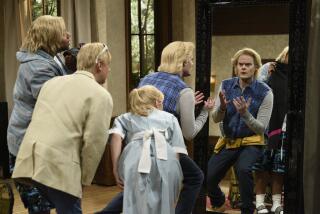Book Review : ‘Snooze’ Turns Out to Be a Big Snore as a Parody
Snooze, the Best of Our Magazine, conceived and created by Alfred Gingold and John Buskin (Workman Publishing: $8.95)
If a joke announces: “This is a joke,” it lets the air out of its own tires. “Snooze,” a bulky spoof of the New Yorker, droops at the start by placing on its cover a conspicuous white box identifying it as an “Unauthorized Parody.”
I suppose the lawyers are to blame. But perhaps you have to choose between doing parity and doing lawyers. A cautiously reckless parody is like a bobsledder who brakes for squirrels.
“Snooze’s” cover shows the New Yorker’s eponymous Eustace Tilley accepting delivery of a pie in the face. The type, heading and line-breaks closely follow the New Yorker’s style. And its contents--short stories, cartoons, profiles, notes and comment, reviews--are easily identifiable take-offs of dozens of the magazine’s best-known contributors.
Alfred Gingold and John Buskin, who thought up and organized “Snooze,” had a bright idea. The New Yorker, which does a certain amount of parodying of its own, is an institution whose virtues have acquired their own defects.
Its loyalty to its writersincludes loyalty to their stalenesses. Its willingness to be interested in almost everything--at least in its nonfiction--can produce material that interests very few. (“Annals of Sand” is one of the better titles among the parodies.) It has always published to please itself and, again, the pleasure is sometimes quite restrictive.
I think the virtues are precious enough to more than compensate for the defects, but parody is certainly in order. Particularly if, as reported, the magazine wouldn’t run an advertisement for “Snooze.”
Back to the bright idea. In this case, it is a bright idea that grew, which is not always a good thing. Gingold and Buskin gathered some 30 writers, artists and designers, as well as writing quite a bit themselves. The result is 269 pages of text and three pages that match contributors to their parodies. That also seems droopy; like graffiti that is signed and addressed, and offers the agent’s phone number.
At best, “Snooze” is like a five-gallon jug of cocktail onions. Some of them sparkle, but they ride atop a great deal of ballast. I suspect its size and thoroughness was thought of as part of the joke; like building an ice cream sundae not merely two feet high, but 20.
Sorting it all out is bound to be arbitrary work. No doubt it is best taken in small portions, now and then; but that would pretty well preclude reviewing it.
In quite a few cases, a nice idea is no more than that. To parody John Cheevers’ “The Swimmer” by having the protagonist drink rather than swim his way across his suburb is a good enough notion, except that you will probably not want to follow it that far. An S. J. Perelman-like journey in search of Harold Ross, the first editor, is a one-line twist that goes on for seven pages. The point of a Pauline Kael skit is that she writes very long; and so does her parodist.
The shorter samples, no doubt inevitably, tend to work best. I liked a one paragraph review of “The Semiotic Cookbook” and another of “Bog,” “a history of four
square inches of Georgia swampland.” The “About Town” sections contain such items as “The Harold Stassen Dance Co.” and a whole category listing the best lines to stand in (Department of Motor Vehicles and so on.).
Some of the parodies, such as one on J. D. Salinger, “A Nice Day for Banana Daiquiris,” seem to plod on endlessly in whimsical parallel with their subjects, and never really engage them. A few are quite delightful. I particularly liked a Ludwig Wittgenstein parody by Judith Gingold. It is, of course, about meaning and its morasses. Here is a sample:
“Thus we might teach a child the meaning of ‘red’ by pointing to a stop light, an apple, or a Communist. But we do not invariably use this form of explanation. If a child asks, ‘What is the meaning of “antidisestablishmentarian,” ’ we would not ordinarily respond by pointing to a dead Irish churchman. More likely, we would simply tell the child to look it up in the dictionary, or to get lost. These, too, are forms of explanation.”
What is striking about this piece and several others is that they could pretty well have appeared in the New Yorker. This is especially true of many of the cartoons.
Throughout, in fact, “Snooze” oscillates between parodying the original and imitating it. The imitations tends to succeed better. Except in countries where it is illegal, and the author risks death, parody needs to be almost witty and agile enough to stand on its own; and “Snooze’s” draw most of their strength from the thing being parodied.
The most successful instance, in fact, may actually be self-parody. The New Yorker can go on and on. “Snooze” can go on and on and on. By and large, it will get you to sleep faster.
More to Read
Sign up for our Book Club newsletter
Get the latest news, events and more from the Los Angeles Times Book Club, and help us get L.A. reading and talking.
You may occasionally receive promotional content from the Los Angeles Times.








